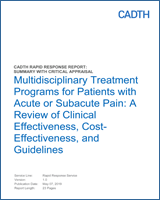| Ameis,12 2018, Canada |
|---|
The objective was clearly stated Multiple databases (MEDLINE, EMBASE, AMED, several guidelines databases) were searched January 1990 to May 2015 Study selection was described and a flow chart was presented A list of included studies was provided Article selection was done independently by two reviewers Quality assessment (risk of bias) was done independently by two reviewers. The relevant included studies were judged to be of good quality Data extraction was conducted by one reviewer and checked by a second reviewer Characteristics of the included studies were presented
|
A list of excluded studies was not provided Publication bias does not appear to have been examined Meta-analysis was not conducted (not feasible considering the small number and heterogeneity of studies) Conflicts of interest of the authors were not presented
|
| Oliveira,13 2018, Brazil |
|---|
The objective was clearly stated Multiple databases (MEDLINE and PEDro, and from National Guideline Clearing house and NICE) were searched between 2008 and 2017. In addition reference lists of relevant reviews and guidelines, and Web of Science citations, were searched and experts in the field were consulted. A list of included studies (guidelines) was provided. Article selection was done independently by two reviewers. Data extraction was done independently by two reviewers. Quality assessment of the included guidelines was conducted. Quality assessment was based on the following criteria: multidisciplinary group committee, systematic literature search, strength of evidence, consensus, direct link of evidence to recommendation, external review, clear recommendation, time of updating, strategies as well as barriers and facilitators for implementation, and additional material for implementation. All of these 10 criteria were addressed in the guideline from Finland, and 80% of these 10 criteria were addressed in the guideline from Spain. Characteristics of the included guidelines were presented but studies providing the evidence were not discussed
|
Study (i.e., guideline) selection was not described and a flow chart was not presented A list of excluded studies (i.e., guidelines) was not provided Unclear if quality assessment of the studies (i.e., guidelines) was conducted Publication bias does not appear to have been examined Conflicts of interest were declared. Of the eight authors, seven authors had no conflicts of interest relevant to their report, and one author received lecture fees from a pharmaceutical company.
|
| Marin,4 2017, Canada |
|---|
The objective was clearly stated Multiple databases (MEDLINE, EMBASE, PsyclNFO, Cochrane Central Register of Controlled trials, Clinical trials registry, and others) were searched up to July 2016 Study selection was described and a flow chart was presented A list of included studies was provided A list of excluded studies was provided Article selection was done independently by four reviewers Data extraction and quality assessment were done independently by four reviewers working in pairs. The quality of the included studies was judged to be of low or very low quality. Characteristics of the included studies were presented Meta-analysis was conducted when appropriate
|
Publication bias was not investigated as there were too few studies to conduct an analysis Conflicts of interest were declared. Seven of the authors had no known conflicts of interest and one author was consultant to AO Spine for an unrelated study Conflicts of interest were declared. Of the eight authors, seven authors had no conflicts of interest and one author had association with industry but it was unrelated to the report.
|
